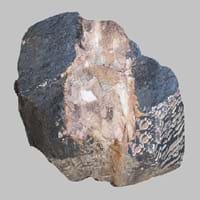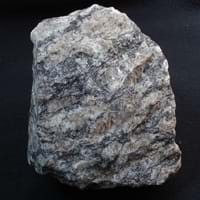Definition
Claystone is a fine-grained, dark gray to pink sedimentary rock which mainly consists of compacted and hardened clay
Gneiss is a common and widely distributed type of rock formed by high-grade regional metamorphic processes from pre-existing formations that were originally either igneous or sedimentary rocks
Discoverer
Unknown
Unknown
Etymology
From English clay and stone as the rock contains more amount of clay
From the Middle High German verb gneist (to spark; so called because the rock glitters)
Class
Sedimentary Rocks
Metamorphic Rocks
Sub-Class
Durable Rock, Medium Hardness Rock
Durable Rock, Hard Rock
Group
Not Applicable
Not Applicable
Other Categories
Fine Grained Rock, Opaque Rock
Coarse Grained Rock, Medium Grained Rock, Opaque Rock
Texture
Clastic
Banded, Foliated, Platy
Color
Black, Blue, Brown, Green, Grey, Orange, Red, White, Yellow
Black, Brown, Pink, Red, White
Durability
Durable
Durable
Scratch Resistant
Yes
Yes
Appearance
Rough and Dull
Foliated
Interior Uses
Decorative Aggregates, Entryways, Floor Tiles, Homes, Interior Decoration
Countertops, Decorative Aggregates, Flooring, Interior Decoration
Exterior Uses
As Facing Stone, Roof Tiles
As Building Stone, As Facing Stone, Garden Decoration, Paving Stone
Other Architectural Uses
Curbing
Curbing
Construction Industry
As a Sintering Agent in Steel Industry to process Iron Ore, Cement Manufacture, Construction Aggregate, for Road Aggregate, Making natural cement, Raw material for the manufacture of mortar
As Dimension Stone
Medical Industry
Not Yet Used
Not Yet Used
Antiquity Uses
Artifacts, Sculpture, Small Figurines
Artifacts
Commercial Uses
Pottery
Cemetery Markers, Jewelry, Tombstones, Used in aquariums
Types
Not Available
Augen Gneiss, Henderson Gneiss, Lewisian Gneiss, Archean and Proterozoic Gneiss.
Features
Available in Lots of Colors and Patterns, Smooth to touch, Very fine grained rock
Generally rough to touch, Is one of the oldest rock
Archaeological Significance
Monuments
Not Yet Used
Used
Famous Monuments
Not Applicable
Konark Sun Temple in India, Washington Monument, US
Sculpture
Used
Not Yet Used
Famous Sculptures
Data Not Available
Not Applicable
Pictographs
Used
Not Used
Petroglyphs
Used
Not Used
Figurines
Used
Not Yet Used
Formation
Claystone is generally quite soft, but can be hard and brittle. It forms due to weathering of mudstone.
Gneiss is a high grade metamorphic rock i.e. it has been subjected to higher temperatures and pressures than schist. It is formed by the metamorphosis of Gneiss forms from volcanic rock, shale or granitie.
Mineral Content
Biotite, Chlorite, Feldspar, Micas, Muscovite or Illite, Plagioclase, Pyrite, Quartz
Biotite, Chlorite, Feldspar, Garnet, Graphite, Hornblade, Micas, Muscovite or Illite, Quartz, Quartzite, Silica, Zircon
Compound Content
Aluminium Oxide, Ca, NaCl, CaO, Iron(III) Oxide, MgO, Silicon Dioxide
Aluminium Oxide, NaCl, CaO, Iron(III) Oxide, FeO, Potassium Oxide, Magnesium Carbonate, MgO, MnO, Phosphorus Pentoxide, Silicon Dioxide, Titanium Dioxide
Types of Metamorphism
Not Applicable
Impact Metamorphism
Types of Weathering
Biological Weathering, Chemical Weathering, Mechanical Weathering
Biological Weathering, Mechanical Weathering
Types of Erosion
Coastal Erosion, Water Erosion
Chemical Erosion, Coastal Erosion, Sea Erosion
Grain Size
Fine Grained
Medium to Coarse Grained
Fracture
Not Available
Irregular
Porosity
Very Less Porous
Very Less Porous
Compressive Strength
Not Available
Specific Gravity
0
2.5-2.7
Transparency
Opaque
Translucent to Opaque
Density
2-2.9 g/cm3
2.6-2.9 g/cm3
Specific Heat Capacity
Not Available
Resistance
Heat Resistant, Impact Resistant
Heat Resistant, Pressure Resistant, Scratch Resistant, Wear Resistant
Deposits in Eastern Continents
Asia
Bangladesh, China, India, Russia
China, India, Iran, Iraq, Kazakhstan, Kyrgyzstan, Mongolia, Russia
Africa
Ethiopia, Kenya, Morocco, South Africa, Tanzania
Cameroon, Ethiopia, Ghana, Kenya, Madagascar, Morocco, Mozambique, Namibia, Nigeria, Tanzania, Togo
Europe
Austria, France, Germany, Greece, Italy, Romania, Scotland, Spain, Switzerland
Albania, Austria, Bosnia and Herzegovina, Finland, France, Georgia, Germany, Hungary, Italy, Kosovo, Monaco, Norway, Poland, Romania, Serbia, Slovakia, Slovenia, Switzerland, Ukraine, United Kingdom
Others
Not Yet Found
Not Yet Found
Deposits in Western Continents
North America
Canada, Panama, USA
Canada, Costa Rica, Cuba, Mexico, Panama, USA
South America
Bolivia, Chile, Colombia, Ecuador, Peru, Venezuela
Argentina, Bolivia, Brazil, Chile, Colombia, Ecuador, Peru, Venezuela
Deposits in Oceania Continent
Australia
New South Wales, New Zealand, Queensland, Victoria, Western Australia
New South Wales, New Zealand, Queensland, Victoria
Claystone vs Gneiss Characteristics
Though some rocks look identical, they have certain characteristics which distinguish them from others. Characteristics of rocks include texture, appearance, color, fracture, streak, hardness etc. Claystone vs Gneiss characteristics assist us to distinguish and recognize rocks. Also you can check about Properties of Claystone and Properties of Gneiss. Learn more about Claystone vs Gneiss in the next section. The interior uses of Claystone include Decorative aggregates, Entryways, Floor tiles, Homes and Interior decoration whereas the interior uses of Gneiss include Countertops, Decorative aggregates, Flooring and Interior decoration. Due to some exceptional properties of Claystone and Gneiss, they have various applications in construction industry. The uses of Claystone in construction industry include As a sintering agent in steel industry to process iron ore, Cement manufacture, Construction aggregate, For road aggregate, Making natural cement, Raw material for the manufacture of mortar and that of Gneiss include As dimension stone.
More about Claystone and Gneiss
Here you can know more about Claystone and Gneiss. The life cycle of a rock consists of formation of rock, composition of rock and transformation of rock. The composition of Claystone and Gneiss consists of mineral content and compound content. The mineral content of Claystone includes Biotite, Chlorite, Feldspar, Micas, Muscovite or Illite, Plagioclase, Pyrite, Quartz and mineral content of Gneiss includes Biotite, Chlorite, Feldspar, Garnet, Graphite, Hornblade, Micas, Muscovite or Illite, Quartz, Quartzite, Silica, Zircon. You can also check out the list of all Sedimentary Rocks. When we have to compare Claystone vs Gneiss, the texture, color and appearance plays an important role in determining the type of rock. Claystone is available in black, blue, brown, green, grey, orange, red, white, yellow colors whereas, Gneiss is available in black, brown, pink, red, white colors. Appearance of Claystone is Rough and Dull and that of Gneiss is Foliated. Properties of rock is another aspect for Claystone vs Gneiss. The hardness of Claystone is 3.5-4 and that of Gneiss is 7. The types of Claystone are Not Available whereas types of Gneiss are Augen Gneiss, Henderson Gneiss, Lewisian Gneiss, Archean and Proterozoic Gneiss.. Streak of rock is the color of powder produced when it is dragged across an unweathered surface. The streak of Claystone and Gneiss is white. The specific heat capacity of Claystone is 0.92 kJ/Kg K and that of Gneiss is Not Available. Depending on the properties like hardness, toughness, specific heat capacity, porosity etc., rocks are resistant to heat, wear, impact, etc.Claystone is heat resistant, impact resistant whereas Gneiss is heat resistant, pressure resistant, scratch resistant, wear resistant.





